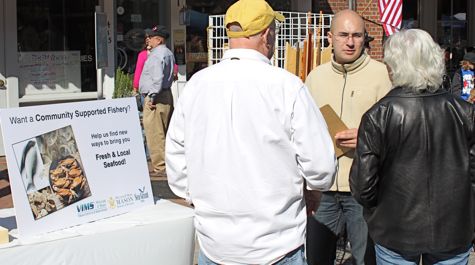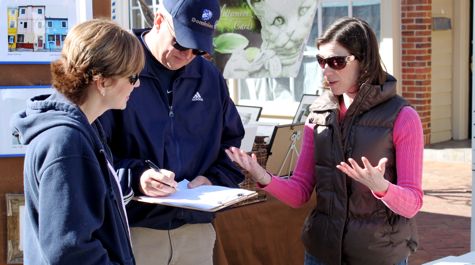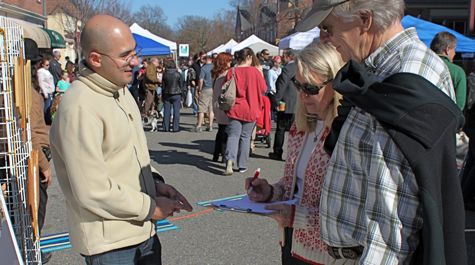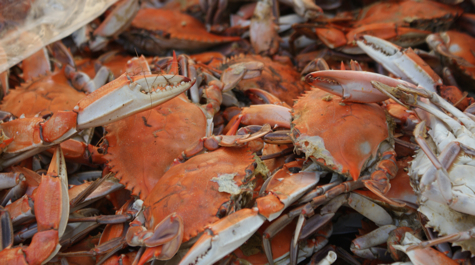Partnership explores feasibility of community-supported fishery
Project team seeks input from local seafood lovers
Local seafood once provided a major economic and cultural link between Chesapeake Bay and the people in its watershed. Today—with a few exceptions—the crabs, oysters, and fish on your plate are more likely to come from the Gulf Coast, Caribbean, or Far East.
A new partnership between Virginia Sea Grant and the College of William and Mary—including the Virginia Institute of Marine Science, Mason School of Business, and Marshall-Wythe School of Law—is exploring whether a community-supported fishery is a feasible means to help reverse this trend by promoting greater consumption of locally harvested fish and shellfish.
Project leader Troy Hartley, Director of the Virginia Sea Grant program at VIMS, says “Community-supported fisheries—‘CSFs’—connect fishermen directly to local markets. Consumers pay for a share of the fishermen’s catch, and in return receive fresh seafood on a regular basis. CSFs are based on the model of community-supported agriculture, which provide subscribers with shares of produce and other products from local farms.”
In addition to Hartley, the project team includes Michael Luchs, an Assistant Professor of Marketing in the Mason Business School; VIMS graduate student Gar Secrist, head of the VIMS “Green Team;” law students Nicole Benincasa and Michael Boyer; MBA students Rustam Arstanov and Tom Innes; and W&M undergraduates Matt Faust, Zander Pellegrino, and So Jung Youn.
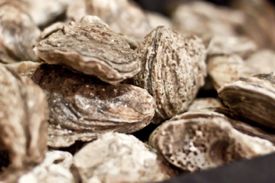 Funding to study the feasibility of a community-supported
fishery in Hampton Roads comes from the College’s Committee on Sustainability.
Established in 2008, the committee uses funds from the Student Green Fee to
promote sustainable practices throughout W&M and nearby communities.
Funding to study the feasibility of a community-supported
fishery in Hampton Roads comes from the College’s Committee on Sustainability.
Established in 2008, the committee uses funds from the Student Green Fee to
promote sustainable practices throughout W&M and nearby communities.
The first part of the feasibility study—telephone and in-person interviews with W&M students, faculty, and staff—wrapped up in late February. The goal was to assess the respondents’ current seafood choices, knowledge of sustainability issues, local-seafood preferences, and willingness to pay for local fishery products.
The study was conducted by undergraduates in Luchs’ Marketing Research class. He says the experience “provided a valuable opportunity to apply what they’re learning in class to the real world,” and notes that their preliminary results “show significant interest within the William and Mary community in support of locally harvested and sustainable seafood.”
On-Line Survey
The next step in the project begins on March 12, when Luchs and his students build on the interview findings to launch an on-line survey (http://tinyurl.com/88pybhc) that will expand the study into the local community and provide more quantitative results.
Secrist says the goal of the survey is to “identify the factors that would make people more or less likely to participate in a community-supported fishery, including important details such as how often they eat seafood, whether they prefer finfish or shellfish, what day and time would be most convenient for pick-up, how much they’re willing to pay for fresh local products, and the criteria they use to decide what counts as ‘local’ and ‘fresh.’”
If the findings of the on-line survey confirm the positive comments from the interviews, the project team will move on to create a detailed business plan that identifies how to best proceed in terms of staffing, storage, transport, finance, legal arrangements, and other factors. Law student Nicole Benincasa is leading this study of the “organizational design” needed to run a successful CSF, with help from undergraduates Faust and Youn.
The team will incorporate lessons learned from a small but growing number of community-supported fisheries at other campuses around the nation, including Duke University and the University of California, Santa Barbara. They will also work closely with LocalCatch.org, a national network of fishermen, organizers, and consumers committed to the growth of CSFs.
A keystone of any community-supported fishery is of course the buy-in and participation of those who provide the seafood—fishermen, watermen, and shellfish growers from Chesapeake Bay and adjacent waters. Secrist says the CSF project team has not yet approached specific seafood suppliers, but is “in the planning stage of engaging the industry through a focus group and meetings with key informants.”
Hartley stresses that market conditions and product supply are unique to every CSF location, but that all CSFs share what he calls “triple bottom-line business goals.” These include increasing the viability of local economies, cultivating healthy ties within and between rural and urban communities, and encouraging an ethic of environmental stewardship.
To participate in the online survey, visit http://tinyurl.com/88pybhc.


